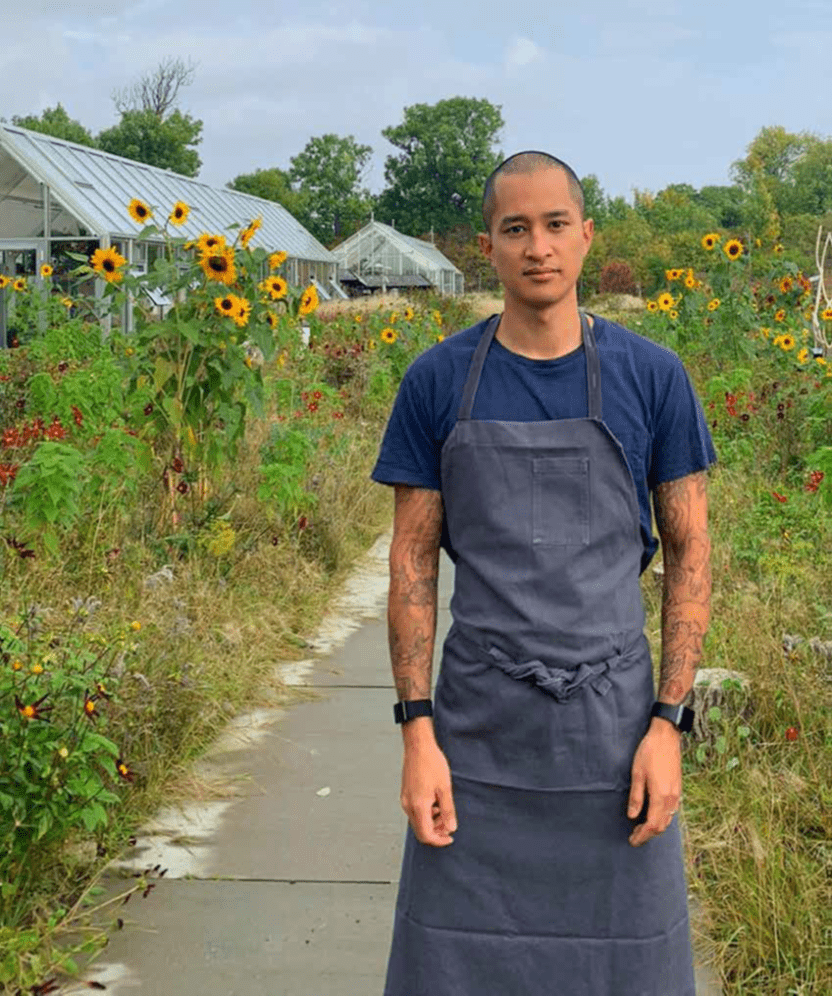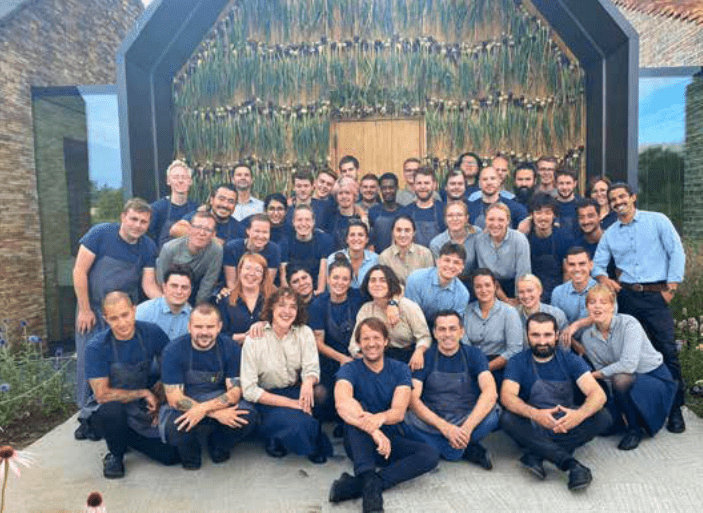Stories > Turning Tables
Turning Tables
Singaporean Kenneth Foong, who is the first Asia-born chef to helm the acclaimed restaurant Noma in Copenhagen, says food helps frame both our commonality and unique identities.
BY KENNE TH FOONG
have always found the kitchen to be a great equaliser. People of all backgrounds work there. So long as your mind is in the right place and you execute the job in a way that’s right for the restaurant, chances are you’ll fit in pretty well. At least that was my experience when I moved from Singapore to New York City to study at the Culinary Institute of America (CIA).
As a new transplant in the Big Apple, I was able to assimilate into an open and inclusive culture. When I needed a primer to unfamiliar national holidays such as Thanksgiving, I could always sit down for dinner with my American friends and learn about their culture. Of course, it helped that the CIA had a diverse student body from more than 30 countries. Being in an environment where everyone spoke the same language – a passion for the culinary arts – was eye-opening.

Singaporean Kenneth Foong, Noma’s first Asian-born head chef, is inspired by the work of Andre Chiang and Corey Lee, and champions cultural diversity in the culinary field.
That lingua franca has been apparent throughout my career as a chef. Food is certainly a conduit for all kinds of connections and experiences. At Noma, its largely international staff – some of whom do not even speak English – gather every day to share food and enjoy one another’s company.
We always get excited over staff meals, which are prepared by interns whose personalities and cultures are reflected in their dishes. On any given day, we have Taiwanese making dumplings and noodles and Italians whipping up pizzas.
The act of enjoying good food is universal. Almost 70 per cent of Noma’s guests are from overseas but their responses to tasting something delicious and unfamiliar are similar.
Clearly, food transcends cultures, of which there are many I interact with in professional kitchens. People have different social norms depending on their cultural background, and as a head chef, I need to put myself in others’ shoes to understand how they may perceive bits of information. While I cannot pinpoint a specific instance where I have had to exercise sensitivity, coming from multicultural Singapore, the need to interpret foreign cultures under a positive light isn’t lost on me.
As far as I can remember, I have always gravitated towards the kitchen. Some of my earliest memories are that of me attempting to help my mother there. I am very much drawn towards the idea of making people happy, and in retrospect, cooking was an easy way to make that happen.
“MY SINGAPOREAN IDENTITY INVARIABLY GUIDES ME IN MY LINE OF WORK. I WAS RAISED IN AN OSTENSIBLY ASIAN HOUSEHOLD THAT VALUED MANNERS, DISCIPLINE AND HARD WORK – A TREMENDOUS FORCE IN THE KITCHEN.”
After completing my National Service, I made my foray into fine dining with a stint at Restaurant Andre in Singapore. This introduced me to the kitchen brigade system, as well as a new paradigm of restaurants. I liked how Taiwanese chef Andre Chiang ran his namesake establishment – with a well-organised corporate structure and solid key performance indicators in place, a reflection of the city-state’s efficiency.
BREAKING GLASS CEILINGS
Asian chefs such as Chiang and Corey Lee, whose flagship restaurant Benu was the first in San Francisco to be awarded three Michelin stars, are a huge inspiration to young Asians. This is especially as there weren’t many influential contemporary Asian chefs when I was growing up. In the early 2000s, most cookbooks and restaurants were Eurocentric.
Regardless of whether you believe in racial bias, I am certain that as an Asian leading French-inspired American restaurant French Laundry, Lee had to work harder. Legends about his technical skills may precede him, but I have had the chance to visit his kitchen and they aren’t unsubstantiated. I witnessed a genuine admiration from his chefs, who displayed a desire to learn from the master chef.
Today, thanks to such restaurateurs, non-Western cultures are better represented in the Western culinary world. More can be done to change perceptions, though.
“CUISINE AND CULTURE ARE INSEPARABLE ASPECTS, AND WHILE HAWKER CULTURE IS DE RIGUEUR AT THE MOMENT, IT DOES NOT MEAN WE HAVE REACHED THE END OF THE CULINARY REVOLUTION IN SINGAPORE.”
Outside of China and Hong Kong, for instance, I still struggle to find that quintessential three-Michelin-star Chinese restaurant. Ethnic cuisine, when categorised as anything non-Caucasian, is generally not placed on the same pedestal as vaunted European establishments. Even in Singapore, Asian food is commonly regarded as the more affordable alternative, and banquetstyle Chinese restaurants don’t fall under the “fancy” category.
I think this is largely due to an information divide. While social media channels such as Instagram play a huge role in rewiring the way people look at food, China has its own channels of distributing information that may not be filtered to the rest of the world. One of my long-term goals is to visit the country, draw that metaphorical digital curtain, and submerge myself in its culture to truly understand its cuisine.
An interesting trend we are seeing is that Asian chefs of my generation are reclaiming their ethnic cuisines, after discarding them when they were younger. I have certainly gained a newfound appreciation for Cantonese cuisine – which I found boring as a child – as I gain awareness of the technical mastery behind it. Indeed, there is a lot of gongfu that goes into making Cantonese food. Chefs require personal experiences to develop a vocabulary to express themselves as individuals, and for me, a lot of that lies in the food I tasted when I was young.
SINGAPORE FLAIR
Beyond that, my Singaporean identity invariably guides me in my line of work. I was raised in an ostensibly Asian household that valued manners, discipline and hard work – a tremendous force in the kitchen.
In the same vein, my time in the army taught me many lessons that helped me get to where I am today. I was placed in a situation where everyone was equal, and you must work with not just your insecurities but that of others. I barely graduated from Officer Cadet School, and it made me realise that titles are irrelevant – you have to earn your right to leadership every day and be accountable to your team.
Speaking of home, Singapore’s fine dining scene has grown by leaps and bounds since I started out as a chef, and the Michelin guide did not have a presence here. The country has strong local talent, and excels in its proliferation of casual fine dining options such as Le Bon Funk.
Though the Michelin rating system has its fair share of critics, I feel that getting recognition adds a little fuel to the tank and takes us a little further each time. At the end of the day, however, if a Michelin star is the only thing a restaurant is striving for, it may have gotten its priorities wrong.
On the other end of the spectrum, Singapore’s hawker culture was added to the Unesco List of Intangible Cultural Heritage. While getting on the list is one thing, the real work that needs to be done lies in educating people and advancing the concept of hawker dining.

Kenneth Foong (front row, first from left) is inspired by the multicultural diversity at Noma that employs mostly international staff from around the world.
Too many individuals attempt to fit Singaporean cuisine and food culture into the existing genres and come up short. We have to remember that Singapore as a country has only existed independently for over 50 years.
At this point, the best estimation of what “culinary tradition” is in Singapore is an amalgamation at best. Compare that to our European counterparts: For example, how long did it take for French cuisine to exist independently from European cuisine, and consequently pave the way for Burgundian or Parisian cuisine that are now textbook terms?
Cuisine and culture are inseparable aspects, and while hawker culture is de rigueur at the moment, it does not mean we have reached the end of the culinary revolution in Singapore. Certainly we should continue building on our culinary tradition – although doing so will necessitate taking factors like labour, the lack of local produce, consumer expectations and costs into consideration. It is a complex and time-consuming process, and requires patience. For a start, though, Singaporean cuisine can and will always be associated with accessibility, variety, spice and tastiness.
On this note, I must say that our visa system is probably due for an overhaul so as to bring greater diversity into kitchens that is essential to creativity.
One of the best things about working in kitchens is that you work with such a diverse group of people from different backgrounds, and to have many regulations that bar entry to the workforce can create a rather uninteresting group of people that may lack a variety of outlook. I understand that it is the government’s prerogative to protect jobs, but many roles in my industry aren’t necessarily popular among locals.
In the future, I hope to see our local talent stepping up with contemporary concepts that are uniquely Singaporean, which is already happening in places such as Labyrinth run by Han Li Guang. Paradoxically, I also rather selfishly hope the dining scene won’t change because so much of who we are is tied to our food culture.
There is something comforting in the idea that I can return home and visit my favourite zi char [stalls selling homecooked- style Chinese food] place where I know all the aunties and uncles, and I can bring my own wine. That, to me, is the perfect Singaporean meal, with an unmistakable familiarity of flavours.
ABOUT THE AUTHORKenneth Foong is a Singaporean culinary master and the first Asian-born head chef of the award-winning, two-Michelin-star restaurant Noma in Copenhagen. Having studied at Singapore’s prestigious Anglo- Chinese School, he graduated from the Culinary Institute of America. The 31-yearold then worked at well-known New York City eateries such as the now-defunct Betony and Eleven Madison Park, followed by stints at Singapore gastronomy establishments such as Restaurant Andre and Cure. He joined Noma as an intern and within nine months was offered a full-time position, which was quickly followed by another promotion to the position of head chef at the acclaimed Nordic restaurant. Foong is married to a Mexican chef whom he met during his tenure at Eleven Madison Park. |
